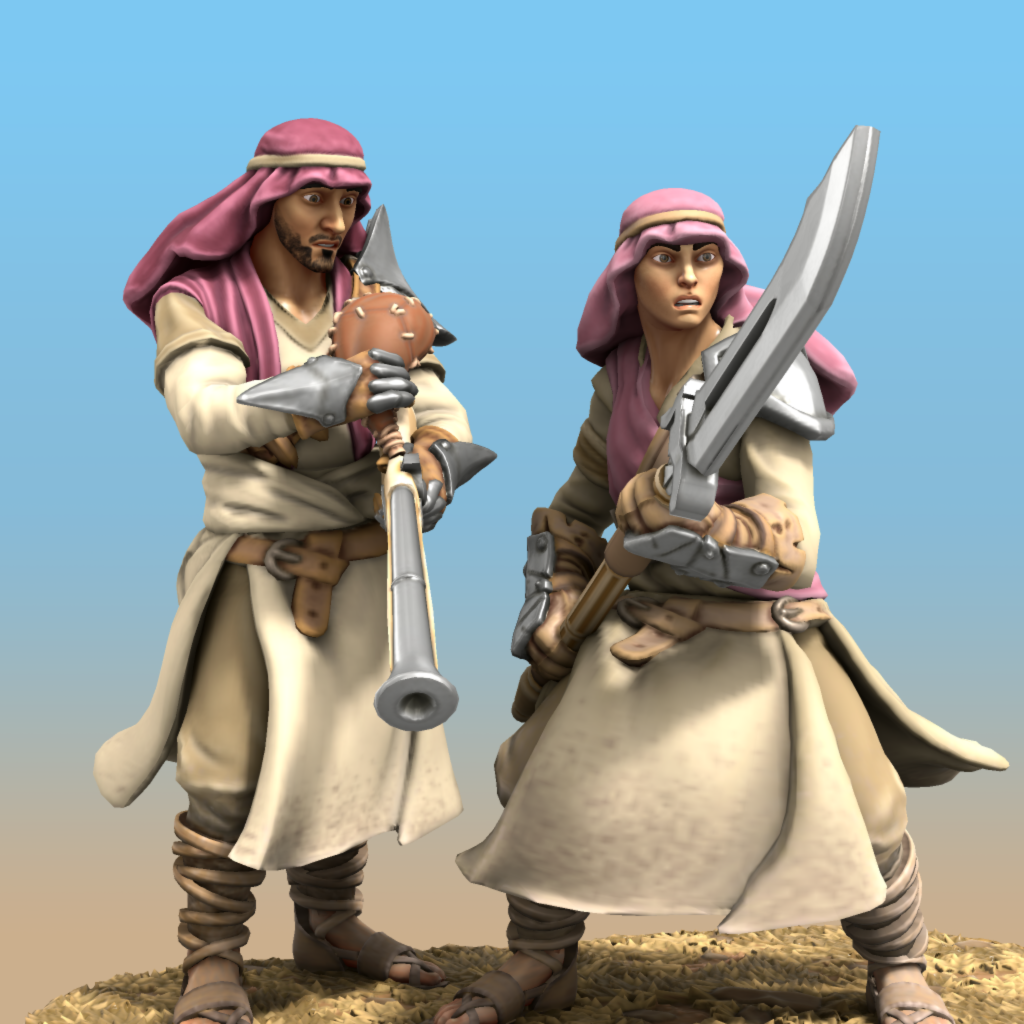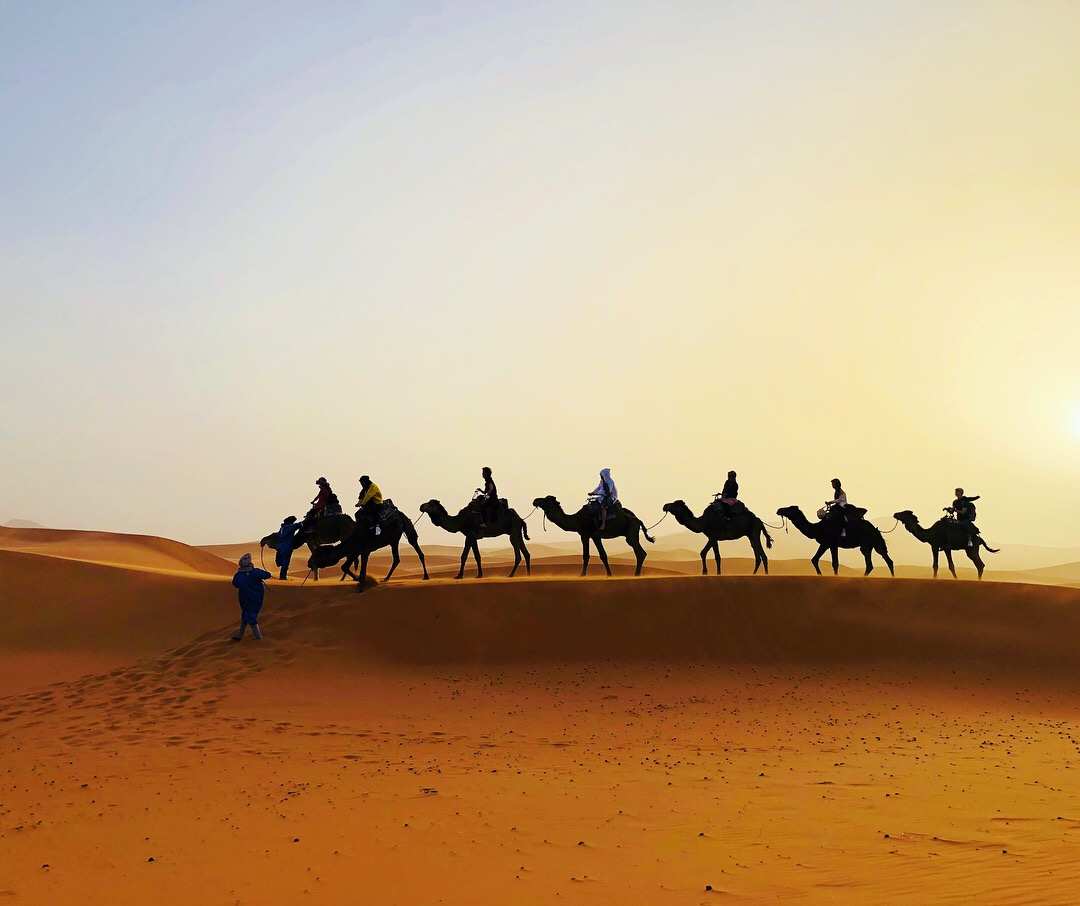Itbaqaan - Combined Arms Unit
Boom! Rush, crash, recede. Boom! Rush, crash, recede. Boom! Rush, crash, recede. The wide-eyed man's interrogators listened silently, unsure how long he was going to keep repeating himself. It was like lightning, constant lightning and thunder. It gave us no rest. Soon as we regrouped and tried to rush 'em again, Boom! We could hardly touch 'em.The Itbaqaan (lit. "dual strike" or "two-pronged assault") are elite shock troops, mixed weapons units in which two rows of arquebusiers load and fire their weapons in a staggered patterns while several rows of pikemen in front of them hold off or put added pressure on opposing units. Originally an invention of the armies and marines of the city-state of Andaen, the itbaqaan have since been replicated by relatively well-to-do city-states and petty kingdoms across the Haifatneh Basin. However, the extensive training and significant armament of firearms required to assemble an Itbaqaan unit have resulted in their adoption remaining far from widespread.- Excerpt from a recorded interview with a Takheti insurrection leader (anonymous) providing his account of the Igh-Berkaana Incident.
Unit Organization and Composition
While it is normally unusual for a mixed-arms unit featuring firearms to have a ratio of melee combatants to firearm-wielders smaller than eight to one, the earliest successful iterations of Itbaqaan units operated with a four-to-one ratio of pikemen to hand cannoneers, typically two hundred soldiers in total. With further advancements in both the discipline of these units and the efficacy of their weapons, commanders of these units could further reduce this ratio to three to one. The most elite, decorated units, outfitted with the latest models of arquebuses—or rather, the latest models tested for safety and reliability—operate at a three-to-two ratio, with three rows of pikemen serving a largely supportive role for two rows of arquebusiers (each row consisting of thirty soldiers).Equipment
The soldiers of the Itbaqaan are lightly armored at most, typically with helmets, limited upper body armor, and for the front row of pikemen, shields to fend off attacks from the most likely angles; the pikemen are more heavily armored than the arquebusiers by default. The best-trained units of Itbaqaan tend not to use the aforementioned shields. The main strength of an Itbaqaan is its ability to carry out a rhythmic, relentless offensive that precludes the possiblity of an opposing unit's counter-offensive. Additionally, the weaponry of an Itbaqaan is quite expensive, leading most quartermasters to focus their spending on ensuring these units' offensive capabilities.Training and field operations
The training requirements of the Itbaqaan are considerable, given not only the base requirement of training a significant number of soldiers in the use of firearms but also raising other soldiers with the nerves of steel necessary to form and re-form a wall of pikes between each volley of bullets. The expense of the numerous live-fire drills necessary to perfect the clockwork-like routines of the arquebusiers can be burdensome for forces that are not already generously funded. The signature tactic of the Itbaqaan, usually termed "relentless thunder" or "thundering assault" by commanders and military historians, consists of the two rows of arquebusiers staggering their volleys such that while one row is aiming and firing their weapons, the other row is reloading theirs. Meanwhile, several rows of pikemen take their positions in front of the arquebusiers, mainly acting as a steel wall ensuring that the arquebusiers are not interfered with while they ready their weapons. Given that opposing units are typically highly motivated to interrupt this steady rhythm of volleys, the best-trained Itbaqaan pikemen are known for ferociously menacing the opposing infantry in order to dissuade a counterattack. Counteracting the din of battle, drummers and horn-blowers help set the pace of this thundering assault. Typically, one or two horn-blowers are paired with each row of arquebusiers, not to give orders to the arquebusiers themselves but to signal to the pikemen when they should disengage to let the next volley of bullets do its deadly work. Some units even use horns of two different sizes or from two different species of animals, one for each row of arquebusiers. One or two drummers, meanwhile, serve to provide a steady working rhythm for the gunners, though the most seasoned Itbaqaan units achieve sufficiently rapid and consistent reloading times so as to dispense with signal-drummers entirely.Auxiliaries
- Quartermaster: While quartermasters are essential for every organized military body, each Itbaqaan has its own dedicated quartermaster (who answers to the head quartermaster of an army or marine force) who procures large supplies of black powder, bullets, and spare firearms to ensure the unit's ability to carry out its famously relentless advances. Quartermasters of Itbaqaan are nearly legendary for their ability to judge how many volleys of firearm attacks their units are capable of and to judge the current functioning, on average, of the unit's weapons by counting in seconds the reload time between one volley and the next. In those Itbaqaan with the smallest ratio of pikemen to arquebusiers, the ability to fire volleys at a relentless pace is considered the unit's chief strength, with the pikemen mainly serving to hold off opposing advances between volleys. Thus, the status of the quartermaster of an Itbaqaan is such that they can overturn the unit captain's orders to attack or advance if they deem the unit's supplies of bullets or black powder to be insufficient.
- Unit Captain: In addition to communicating orders from battlefield leadership, the unit captain is charged with coordinating the signallers and evaluating the performance of arquebusiers and maintenance personnel in real time to ensure the smooth operation of their unit.
- Signallers: Each unit has one or two drummers and horn-blowers assigned to it.
- First Aid: A holdover from earlier experiences with less reliable firearms, as many as half a dozen first aid personnel, often nicknamed "burn-wrappers," accompany the unit on standby to provide rapid triage and wound-dressing in the event of any explosions or similar accidents.
- Maintenance: Maintenance personnel, sometimes jokingly referred to as "pipe-cleaners" or by cruder nicknames, are low-ranking yet important personnel who are assigned on standby specifically to help arquebusiers trouble-shoot jammed or otherwise faulty firearms between volleys. In coordination with the unit's quartermaster, they ensure that their unit can cycle through volleys and pike-brandishing maneuvers like clockwork.
- Resolutes: Shield and scimitar-wielding troops are occasionally assigned to an Itbaqaan when upper leadership anticipates heavy involvement in close-quarters combat, vulnerability to flanking, or other situations in which the unit may be hemmed in and find its pikemen alone insufficient for protecting its arquebusiers. Resolutes march along each side and/or the rear of the column as directed by their captain.
History
The question of firearms in the field
Black powder and the first firearms are originally products of the end years of the Warlord Era of Au-na-Lai, and the hand cannons that are seeing increasing use in the Haifatneh Basin and Near Takhet regions are now deemed crude by the peoples of that realm. Hand cannons and more advanced firearms such as arquebuses have also seen limited adoption in part due to their unpredictability, and in small part out of fear that opposing armies who employ mages are capable of detonating black powder caches from afar. Nonetheless, the military leaders of Andaen are always seeking means to use their city-state's considerable funds and access to foreign products to gain an edge over rivals. Thus, not only were Andaeni infantry early adopters of handheld firearms for regular military use, but Andaeni commanders—no enjoying the generous funding that necessarily came with shipments of these advanced arms—quickly sought to integrate these slow yet potent weapons into their regular operations. Black powder weapons are slow to reload and difficult to manage under duress—say, during a melee assault by an opposing military unit—making them broadly disfavored for use en masse by an entire military unit. (The rumors of exploding weapons, sometimes as the result of opposing mages' spellcraft, have onlfurther discouraged militaries from storing or deploying many firearms in one place.) A number of militaries across the Haifatneh Sea sought to overcome this shortcoming by deploying hand cannoneers as auxiliary troops within melee units, yet coordinating blasts from firearms with the advancing maneuvers of pikemen, swordsmen, and the like proved a logistical nightmare in many cases. The key to solving this logistical problem was the employment of drummers and horn-blowers, a custom which originated from tribal Haifatnehti rituals for rallying volunteers in defense of their villages. Though the adoption of firearms in Andaen and elsewhere across the Haifatneh Sea began long after the once-rich Haifatnehti cultural heritage was badly disrupted by the ravages of the Crusade and the Reconquest, the wartime drills and music of the Haifatnehti tribespeople were readily adapted to the field operations of the Rebel Coalition that drove the occupying Crusaders back into the northern ocean from whence they came.Noted successes of the Itbaqaan
If it were not for Andaen's largely peaceful relations along the shores of the Haifatneh through its numerous spheres of influence, it is possible that the Itbaqaan would have occasion to devastate great numbers of rival infantry forces. Filing down opposing infantry units, particularly melee combatants, is the main function of the Itbaqaan, with some unit commanders gloating that they can "clear" a rival unit of double their number within ten minutes of combat. Itbaqaan also tend to fare well against cavalry, with horses and camels being even more spooked by the thundering and the caustic smell of black powder in action. Itbaqaan have been known to face the most trouble against sufficiently disciplined units of crossbowmen or other archers, as even the best arquebuses have yet to match those weapons in range. The army and marines of Andaen have often succeeded in deploying their Itbaqaan to intimidate rival states by making a devastating example of the first opposing units to face them, leveraging their access to superior funding and resources to overwhelm less equipped foes with volley after volley of bullets. Andaen's forces have won several battles in Agratekt, as well the Haifatneh Sea's west coast, northeast, and southeast in this manner. Itbaqaan have not been regularly deployed in Feshan Alay to the far east or the Tahwame Bounds to the south, where mountainous terrain and less developed infrastructure have limited their operations. The most remarkable and unusual success of an Itbaqaan unit is almost certainly in the resolution of the Igh-Berkaana Incident, in which Andaen materially supported the new leader of the petty warlord state of Tel-Agradar in Near Takhet (by putting down a protest-turned-insurrection with the goal of strengthening the local control over their homeland's politics). Admittedly, this victory had less to do with the Itbaqaan's sheer force of arms than with conflicting goals among the insurgent leaders, but this battle nonetheless qualifies as the first known instance of firearms being used by the winning faction in an instance of urban warfare.
Andaeni Itbaqaan by Eric de Roulet



Comments